unit4 earthquake reading教案
Unit4Earthquakesreading教学设计

U n i t4E a r t h q u a k e s r e a d i n g教学设计(总6页)--本页仅作为文档封面,使用时请直接删除即可----内页可以根据需求调整合适字体及大小--Unit 4 EarthquakesReading A NIGHT THE EARTH DIDN’T SLEEP教学设计一、教学课型:阅读课二、教材分析:Reading部分具体描写1976年河北唐山大地震的震前,震中和震后。
作者详细描述了地震来临前的一些不正常的自然现象及动物的反常表现,地震的来势汹汹,并在顷刻间将整座城市夷为平地和地震结束后人们勇敢地面对事实并及时地实施抢救和重建工作。
本课词汇量大,并运用了大量的动词,使得描写更为生动,文中还有不少复杂的数字,这又增加了文章的阅读难度,另外教学内容Reading —A Night The Earth Didn’t Sleep文章中出现了许多定语从句,对学生的语言阅读能力提出了更高的要求。
三、学情分析:学习的对象是处于城乡结合部的高一学生,他们的英语基础较差,特别是由于词汇量缺乏,阅读习惯不好,导致阅读速度慢、阅读理解能力差。
并且学生在初中已习惯了教师的单向灌输,部分学生由于英语表达能力的欠缺对课堂的互动缺少积极性,不善于交际,学习不够主动自主。
因此,在组织教学活动中,注重学习策略的指导,灌输自主、合作、探究学习的思想,同时注意调整活动任务设置的梯度,使每个学生通过学习活动,都能学有所成,体验到成功。
四、教学目标:1. 语言知识目标:Let the students learn about the words and expressions of earthquake.2. 语言技能目标:(1)Develop the students’read ing skills: skimming,scanning, summarizing, etc.(2)Improve the students’abilities of listening,speaking, reading and writing.3. 情感态度目标:(1)Let the students know the importance of predicting the earthquake.(2)Know how to protect oneself and help others indisasters.(3)Develop the students’ability of cooperative learning.五、教学重点和难点:1. 教学重点:(1)Get the students to learn some signs before earthquake.(2)Get the students to use different reading skills.2. 教学难点:(1)Develop the students’reading ability.(2)Let the students learn to use the time order when writing.六、教学方法:1. Task-based teaching method.2. Cooperative learning.3. Discussion.七、教学过程:StepⅠ: Warming up1. Show students some pictures of the earthquake in Wenchuan and ask students:(1)What happened in the picture? How much do you know about the earthquake(2)Do you know there was still another big earthquakein China during 20th century?[设计意图]多媒体课件展示汶川的有关图片导入课文主题:地震。
高中英语必修1-Unit4-Reading教案
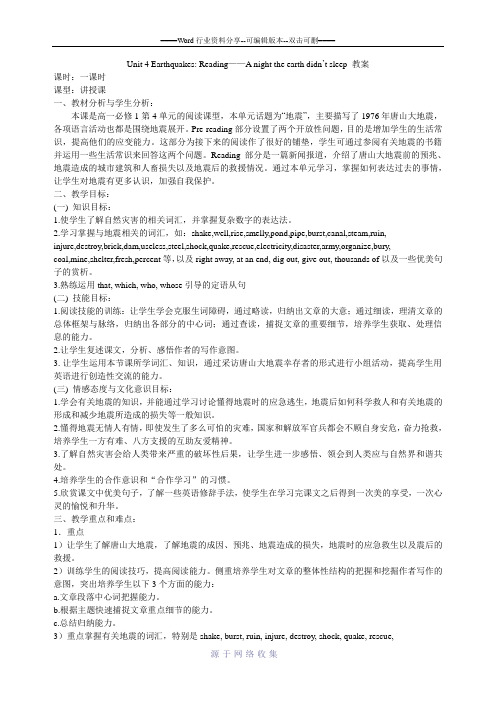
Unit 4 Earthquakes: Reading——A night the earth didn’t sleep 教案课时:一课时课型:讲授课一、教材分析与学生分析:本课是高一必修1第4单元的阅读课型,本单元话题为“地震”,主要描写了1976年唐山大地震,各项语言活动也都是围绕地震展开。
Pre-reading 部分设置了两个开放性问题,目的是增加学生的生活常识,提高他们的应变能力。
这部分为接下来的阅读作了很好的铺垫,学生可通过参阅有关地震的书籍并运用一些生活常识来回答这两个问题。
Reading 部分是一篇新闻报道,介绍了唐山大地震前的预兆、地震造成的城市建筑和人畜损失以及地震后的救援情况。
通过本单元学习,掌握如何表达过去的事情,让学生对地震有更多认识,加强自我保护。
二、教学目标:(一) 知识目标:1.使学生了解自然灾害的相关词汇,并掌握复杂数字的表达法。
2.学习掌握与地震相关的词汇,如:shake,well,rise,smelly,pond,pipe,burst,canal,steam,ruin,injure,destroy,brick,dam,useless,steel,shock,quake,rescue,electricity,disaster,army,organize,bury,coal,mine,shelter,fresh,percent等,以及 right away, at an end, dig out, give out, thousands of以及一些优美句子的赏析。
3.熟练运用that, which, who, whose引导的定语从句(二) 技能目标:1.阅读技能的训练:让学生学会克服生词障碍,通过略读,归纳出文章的大意;通过细读,理清文章的总体框架与脉络,归纳出各部分的中心词;通过查读,捕捉文章的重要细节,培养学生获取、处理信息的能力。
2.让学生复述课文,分析、感悟作者的写作意图。
高一英语必修一Unit-4-earthquakes的阅读公开课课教案

Unit 4 EartquakesYuan XiaoshaTitle: Book1 Unit 4 Earthquakes --- ReadingTarget students: Senior 1Teacher: Yuan XiaoshaTeaching aimsKnowledge aims:1. Enable the students to memorize useful expressions.2. Enable the students to know what to do in an earthquake..Ability aims:1. To train and improve students’ ability to read a passage.2. To improve students’ability to express their own ideas by asking and answering questions.Emotional aims:1. To make the students never lost hope in daily life.2. To develop their habit in helping others.Key and important points :eful expressions(injury, in ruins…)2.How to help students to improve reading skills.Teaching methods:Task-based approach &. Communicative teaching method学情分析及前期预测:高一学生,刚军训完一个月,英语水平总体差距较大,其水平分布呈以下特点:分化情况较明显,学生之间的水平差距较大;学生虽然对英语感兴趣,但学习主动性还有待加强;部分学生对教师的依懒性较强,未能主动通过多种渠道获取信息。
Unit4Earthquake教案设计
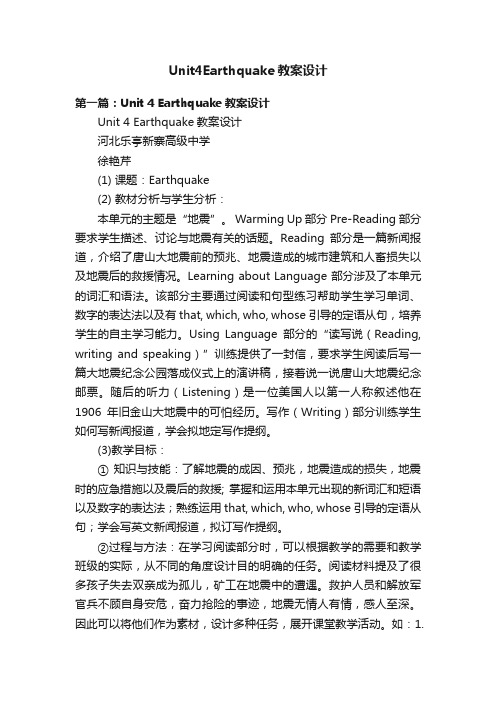
Unit4Earthquake教案设计第一篇:Unit 4 Earthquake教案设计Unit 4 Earthquake教案设计河北乐亭新寨高级中学徐艳芹(1) 课题:Earthquake(2) 教材分析与学生分析:本单元的主题是“地震”。
Warming Up部分Pre-Reading部分要求学生描述、讨论与地震有关的话题。
Reading部分是一篇新闻报道,介绍了唐山大地震前的预兆、地震造成的城市建筑和人畜损失以及地震后的救援情况。
Learning about Language 部分涉及了本单元的词汇和语法。
该部分主要通过阅读和句型练习帮助学生学习单词、数字的表达法以及有that, which, who, whose引导的定语从句,培养学生的自主学习能力。
Using Language部分的“读写说(Reading, writing and speaking)”训练提供了一封信,要求学生阅读后写一篇大地震纪念公园落成仪式上的演讲稿,接着说一说唐山大地震纪念邮票。
随后的听力(Listening)是一位美国人以第一人称叙述他在1906年旧金山大地震中的可怕经历。
写作(Writing)部分训练学生如何写新闻报道,学会拟地定写作提纲。
(3)教学目标:① 知识与技能:了解地震的成因、预兆,地震造成的损失,地震时的应急措施以及震后的救援; 掌握和运用本单元出现的新词汇和短语以及数字的表达法;熟练运用that, which, who, whose引导的定语从句;学会写英文新闻报道,拟订写作提纲。
②过程与方法:在学习阅读部分时,可以根据教学的需要和教学班级的实际,从不同的角度设计目的明确的任务。
阅读材料提及了很多孩子失去双亲成为孤儿,矿工在地震中的遭遇。
救护人员和解放军官兵不顾自身安危,奋力抢险的事迹,地震无情人有情,感人至深。
因此可以将他们作为素材,设计多种任务,展开课堂教学活动。
如:1.组织学生讨论震后孤儿的安置2. 模拟采访被抢救的矿工。
Unit_4_Earthquakes全单元教案
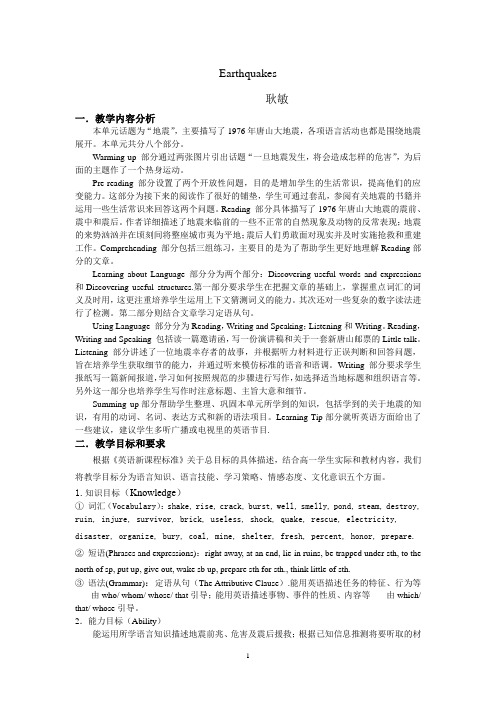
Earthquakes耿敏一.教学内容分析本单元话题为“地震”,主要描写了1976年唐山大地震,各项语言活动也都是围绕地震展开。
本单元共分八个部分。
Warming-up 部分通过两张图片引出话题“一旦地震发生,将会造成怎样的危害”,为后面的主题作了一个热身运动。
Pre-reading 部分设置了两个开放性问题,目的是增加学生的生活常识,提高他们的应变能力。
这部分为接下来的阅读作了很好的铺垫,学生可通过套乱,参阅有关地震的书籍并运用一些生活常识来回答这两个问题。
Reading 部分具体描写了1976年唐山大地震的震前、震中和震后。
作者详细描述了地震来临前的一些不正常的自然现象及动物的反常表现;地震的来势汹汹并在顷刻间将整座城市夷为平地;震后人们勇敢面对现实并及时实施抢救和重建工作。
Comprehending 部分包括三组练习,主要目的是为了帮助学生更好地理解Reading部分的文章。
Learning about Language 部分分为两个部分:Discovering useful words and expressions 和Discovering useful structures.第一部分要求学生在把握文章的基础上,掌握重点词汇的词义及时用,这更注重培养学生运用上下文猜测词义的能力。
其次还对一些复杂的数字读法进行了检测。
第二部分则结合文章学习定语从句。
Using Language 部分分为Reading,Writing and Speaking;Listening和Writing。
Reading,Writing and Speaking 包括读一篇邀请函,写一份演讲稿和关于一套新唐山邮票的Little talk。
Listening 部分讲述了一位地震幸存者的故事,并根据听力材料进行正误判断和回答问题,旨在培养学生获取细节的能力,并通过听来模仿标准的语音和语调。
Writing部分要求学生报纸写一篇新闻报道,学习如何按照规范的步骤进行写作,如选择适当地标题和组织语言等。
Unit4Earthquakesreading教学设计

Unit 4 EarthquakesReading A NIGHT THE EARTH DIDN’T SLEEP教学设计一、教学课型:阅读课二、教材分析:Reading部分具体描写1976年河北唐山大地震的震前,震中和震后。
作者详细描述了地震来临前的一些不正常的自然现象及动物的反常表现,地震的来势汹汹,并在顷刻间将整座城市夷为平地和地震结束后人们勇敢地面对事实并及时地实施抢救和重建工作。
本课词汇量大,并运用了大量的动词,使得描写更为生动,文中还有不少复杂的数字,这又增加了文章的阅读难度,另外教学内容Reading — A Night The Earth Didn’t Sleep文章中出现了许多定语从句,对学生的语言阅读能力提出了更高的要求。
三、学情分析:学习的对象是处于城乡结合部的高一学生,他们的英语基础较差,特别是由于词汇量缺乏,阅读习惯不好,导致阅读速度慢、阅读理解能力差。
并且学生在初中已习惯了教师的单向灌输,部分学生由于英语表达能力的欠缺对课堂的互动缺少积极性,不善于交际,学习不够主动自主。
因此,在组织教学活动中,注重学习策略的指导,灌输自主、合作、探究学习的思想,同时注意调整活动任务设置的梯度,使每个学生通过学习活动,都能学有所成,体验到成功。
四、教学目标:1. 语言知识目标:Let the students learn about the words and expressions of earthquake.2. 语言技能目标:(1)Develop the students’read ing skills: skimming, scanning, summarizing, etc.(2)Improve the students’abilities of listening, speaking, reading and writing.3. 情感态度目标:(1)Let the students know the importance of predicting the earthquake.(2)Know how to protect oneself and help others in disasters.(3)Develop the students’ability of cooperative learning.五、教学重点和难点:1. 教学重点:(1)Get the students to learn some signs before earthquake.(2)Get the students to use different reading skills.2. 教学难点:(1)Develop the students’reading ability.(2)Let the students learn to use the time order when writing.六、教学方法:1. Task-based teaching method.2. Cooperative learning.3. Discussion.七、教学过程:StepⅠ: Warming up1. Show students some pictures of the earthquake in Wenchuan and ask students:(1)What happened in the picture? How much do you know about the earthquake?(2)Do you know there was still another big earthquake in China during 20th century?[设计意图]多媒体课件展示汶川的有关图片导入课文主题:地震。
人教版高中英语必修1《Unit 4 Earthquakes》教案
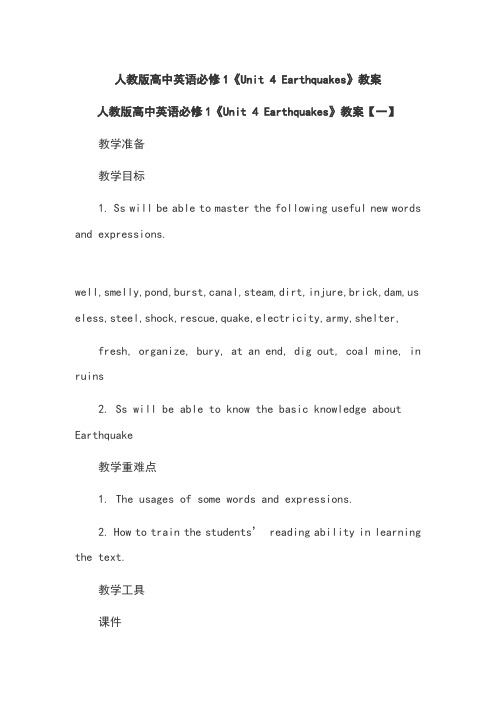
人教版高中英语必修1《Unit 4 Earthquakes》教案人教版高中英语必修1《Unit 4 Earthquakes》教案【一】教学准备教学目标1. Ss will be able to master the following useful new words and expressions.well,smelly,pond,burst,canal,steam,dirt,injure,brick,dam,us eless,steel,shock,rescue,quake,electricity,army,shelter, fresh, organize, bury, at an end, dig out, coal mine, in ruins2. Ss will be able to know the basic knowledge about Earthquake教学重难点1. The usages of some words and expressions.2. How to train the students’ reading ability in learning the text.教学工具课件教学过程Step I lead-inLet students see a short video and answer the questions1.What happened in the video? Earthquakes2.How do you feel seeing the plots(情节)? Students’discussion.Step II Fast reading1. What is the passage mainly about? InTangshan ,earthquakes happened on July 28th 19762. Skim the text and answer the questionsThe type of writing (写作体裁)Narrative writingTopic sentence of Paragraph 1Sentence 1Topic sentence of Paragraph 2Sentence 2Topic sentence of Paragraph 3Sentence 1Topic sentence of Paragraph 4Sentence 1Step III Detailed readingAsk students to read the text carefully and answer the questionsTask1: What were the nature signs of the coming earthquake?(选择)Para 11.Water in well( G )2. Well walls(D )3.Chickens &pigs(F )4 .Mice (A) 5.Fish(E ) 6. Bright lights( B) 7. Water pipes(C )A. Ran out of fieldsB. in the skyC. Cracked and burstD. Deep cracksE. Jumped out of pondsF. Too nervous to eatG. Rose and fell, fell and roseTask 2 Fill in the blanksMain IdeaDetailsDamage caused byearthquakePara 2-3At _____ am, the __________ earthquake of the 20th century began ._______ burst from holes in the ground.Hard hills of the rock became rivers of ____.________ covered the ground like red autumn leaves.Two _______ and most of the bridges fell.The railway tracks were now _________pieces of _______.______ now filled the wells instead of water.Water,food,and ______________ were hard to get.The reconstruction(重建) after the earthquakePara 41. The army _____________2. Workers ____________for survivors.3._____________was taken to the city.Details:1. At 3:42 am, the greatest earthquake of the 20th century began.2. Steam burst from holes in the ground.3. Hard hills of the rock became rivers of dirt.4. Bricks covered the ground like red autumn leaves.5. Two dams and most of the bridges fell.6. The railway tracks were now useless pieces of steel.7. Sand now filled the wells instead of water.8. Water, food, and electricity were hard to get.Step IV consolidation (当堂巩固)Let students fill the blanks according to the passageStrange things were happening in the countryside of northeast Hebei. For three days the water in the village wells kept rising and 1_________(fall). Farmers noticed that the well walls had deep cracks 2___________ them. A smelly gas came out of the cracks. In 3_________farmyards, the chickens and even the pigs were too nervous 4__________(eat). 5_________(mouse) ran out of the fields looking for places 6________(hide). Fish jumped outOf their bowls and ponds. At about 3 am on July 28,1976, some people saw bright lights 7_________ the sky. The sound of planes could 8________(hear) outside the city of Tangshan even 9_________ no planes were in the sky.In the city, the water pipes in some buildings cracked and burst. But the one million people of the city, ________thought little of these events, were asleep as usual that night.1 falling2 in3 the4 to eat5 mice6 to hide 7in 8 be heard 9when 10 who这部分目的是让学生进一步巩固课文的内容。
高中英语人教新课标必修一Unit4 Earthquakes Reading 教案
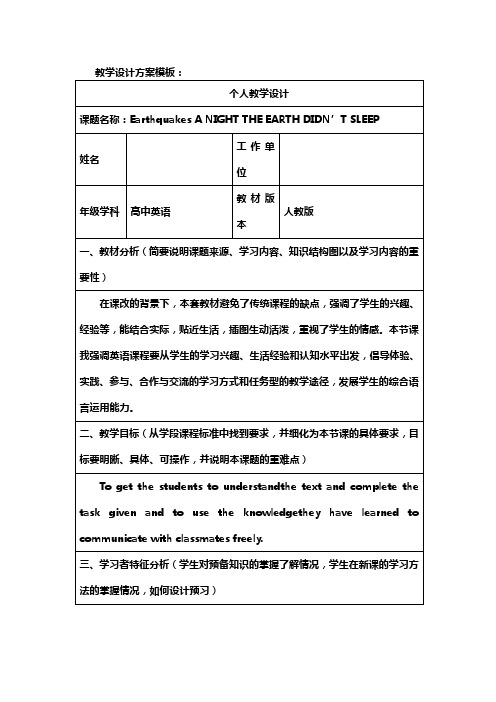
I let the students to think how to write this article themselves if the topic was given to them and this greatly cultivate the students’ divergent thinking.
四、教学策略设计(针对学习流程,设计教与学的方式)
1). To get the students to know basic knowledge about natural disasters
2). To get the students to learn about TangShan Earthquake
三、学习者特征分析(学生对预备知识的掌握了解情况,学生在新课的学习方法的掌握情况,如何设计预习)
素质教育的本质是要培养能够独立学习、自我创新的能力型人才,而新的人教版教材特别注意教材在这方面的设计。我们应该努力朝向让学生成人、成才、成功的方向上引导学生循着科学家的足迹,感受科学探究的一般程序,并从中领悟到科学方法和科学家之所以成功所必须具备的能力。
included—— I deleted the second question in Pre-reading and added a question
New words or phrases
be of pressure from inside
Atan end: finishednation: all the people in the country steam: gas that hot water gives out in ruins:
- 1、下载文档前请自行甄别文档内容的完整性,平台不提供额外的编辑、内容补充、找答案等附加服务。
- 2、"仅部分预览"的文档,不可在线预览部分如存在完整性等问题,可反馈申请退款(可完整预览的文档不适用该条件!)。
- 3、如文档侵犯您的权益,请联系客服反馈,我们会尽快为您处理(人工客服工作时间:9:00-18:30)。
Teaching Plan for Lesson 2, Unit 4, Book 1(Senior 1)Earthquakes教学内容:Lesson 2 for unit 4 Earthquake课型:Reading教学对象:51 students in class 9, senior 1授课时间:40 minutes授课教师:Zhou zhuolingLearning Objectives:1.Predict the possible contents of a text through the title.2.Skimming for main idea of the text. (From the whole text to each paragraph )3.Sum up the main idea of a paragraph by reading the topic sentences as well as key words or phrases.4.Scan for the detail information (when, where, what and result ) by answering questions and filling in the blanks and chart.5.Understand the function of the data in reading.6.Be familiars with the key words and phrases: suffering, canal, burst, at an end, shock, rescue, million, mine, miner, shelter, useless, track, brick, extreme, survivor, trap, electricity, dig out.7.Understand the implied meaning of the text. (We can predict and prepare for the earthquake to reduce the loss, and we should never give up and be united when the disaster comes.)Teaching aids: PPT slides, blackboardTeaching ProcedureStage 1: Leading in (5 minutes)Step 1: Review last lesson. (2 minutes)(T: Class, what we have learned yesterday?T: Yesterday we have learned what may happen before an earthquake. What else?We learned how to protect ourselves in the earthquake. And we also learned what was happening during the earthquake.Step 2: Ss predict the content from the title. (3 minutes)(T: Let's turn to Page 26. Please look at the title of the reading, “ A night the earth didn’t sleep ” Why did the writer say so? What do you think of the title?Step 3: T invites Ss to give their answers.(T: ** , what' s your understanding of the title. )Step 4: T summarizes the Ss' opinions about their understanding of the title.(T: The earth didn't sleep in the night. That is to say, a big disaster may happen there.)(If Ss keep silent, T continues to say :) T: OK. It may be difficult to answer now. Please keep this question in mind. After we finish this lesson, I’d like you to give me your answers.) Stage 2: Fast reading. (8 minutes)Step 1: Skimming: Ss do fast reading to find out the main idea. (5 minutes)(T: Now please read the text quickly, and find out the main idea of this reading. Please pay more attention to the first sentence in each paragraph and the time in the text. And then do the exercises on PPT. You have 3 minutes to go. Now begin.PPT:1) What's the main idea of the text?The passage mainly talks about a(n) earthquake that happened in Tangshan in 1976.2) Match each paragraph with its main idea.Para. 1 A. Damage caused by the earthquake.Para. 2-3 B. Rescue after the earthquake.Para. 4 C. Signs (迹象) before the earthquake.)Step 2: T checks Ss' answers and guides Ss to sum up the main idea of each paragraph by going through the topic sentences as well as the key words and phrase. (3 minutes)(T: This passage tells us an earthquake that happened in Tangshan in 1976.What's the topic sentence in Paragraph 1?What's the topic sentence in Paragraph 2?What's the topic sentence in Paragraph 3?What's the topic sentence in Paragraph 4?)Stage 3: Scanning (Careful reading). (21 minutes)Step 1: Ss read Para. 1 and fill in the chart to show signs before the earthquake. (3 minutes)(T: Let's look at paragraph 1, what strange things happened before the earthquake? Read paragraph 1 quickly and fill in the blanks. You have 2 minutes to go. Now begin.) Chart:TimeWhat happened?People's reactionThree days before the earthquakesWell:_____Nature walls:_____crack:____In the chicken & pig:__countrysideAnimals mice:___Fish: ____People thought little of the quake and they were asleep as usual..At about 3:00 am July 28, 1976See: _______In the sky:Hear: _______In the city: water pipes: ______)Step 2: T checks Ss’ answers. (3 minutes)(T: From which sentence can we know that the water rose and fell? What about walls? Where can we find the answer? What happened to the cracks? Read the sentence that tells us what happened to animals?T: .At about 3:00 am July 28, 1976, what can we see in the sky? What can hear in the sky? What happened to the water pipes?T: There were many strange things that happened before the earthquake. But did the people who lived in Tangshan pay more attention to it? How do you know?)Step 3: Ss read Para. 2-3 and fill in the blanks with data from the text. (3 minutes)(T: Let’s read the paragraph 2 and paragraph 3 quickly; try to find out the data i n Para. 2 and 3. You have 2 minutes. Let’s do it.)PPT:Para. 2-3: Fill in the blanks with data (数据) from the text.² _1/3__ of the nation felt the earthquake.² A huge crack that was __8_ kilometers long and _30_ meters wide cut across houses.² In _15__terrible seconds a large city lay in ruins.² ___2/3__of the people died or were injured during the earthquake.² The number of the people who were killed or seriously injured reached more than_400,000_ .² All the city's hospitals, _78%__ of its factories and buildings and _90%_ of its homes were gone.)Step 3: Discussion: What are the functions (功能, 作用) of these data listed in the text? (2 minutes)(T: We can see that the author uses so many data in Para. 2 and Para. 3. Why does the author use these data? What is the function of these data listed in the text? Discuss with your classmates.PPT:What are the functions (功能, 作用) of these data listed in the text?)Step 4: T invites Ss to share their opinions. (2 minutes)Step 5: T summarizes Ss’ answers. (1 minute)(T: From the data, we can see that the earthquake happened suddenly and it caused a great damage.)Step 5: T guides Ss to pay more attention to the damage of the second earthquake. (2 minutes) (T: Was there only one earthquake in Tangshan? When did the second quake hit the city? What was the result of that? Where can you find the answer?)Step 5: T guides Ss to know more about the rescue after the earthquake. (4 minutes)(T: Great damage caused by the earthquake, Tangshan really suffered a lot from it. Was all hope lost? Which sentence tells us? )(T: Who came to help Tangshan first? Please read last paragraph as quickly as you can and do the exercises on the PPT. You have 2 minutes to do it. One , two, begin.)PPT:Q 1: What did the army do?² The army sent _______ to Tangshan to help _______ .² They organized teams to _____ those who were______.² They also rescued ____ from the coal mines there.Q 2: What did the rescue workers do?² They built ____ for survivors whose homes had been destroyed.)Q 3: What other help did the survivors get?² ____ was taken to the city by train and plane.Step 6: T checks Ss’ answers. (1 minute)Stage 4: Post reading: Summary and homework (6 minutes)Step 1: Free talk: What should we do when we face the disaster? ( 5 minutes)(T: Class, when we face the disaster, what should we do?T: We should be united, we should never give up, we should help each other, we should challenge ourselves.)Step 2: Homework: (1 minute)1. Retell the story according to the time.2. Underline the difficult phrases and sentences.。
